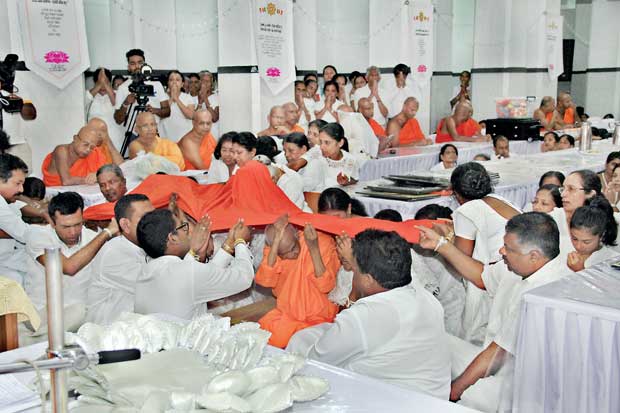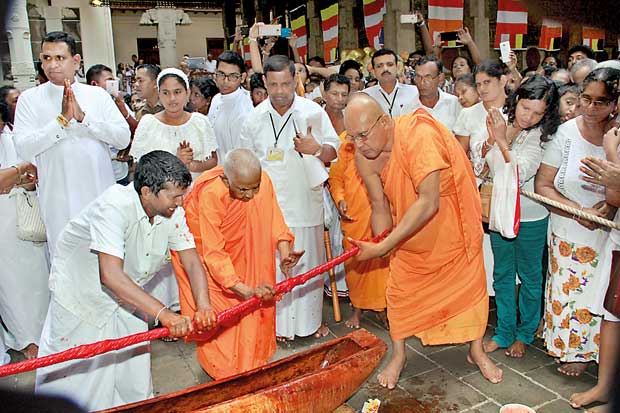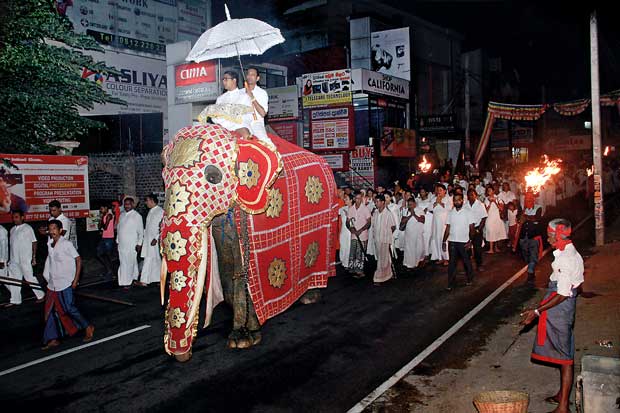Reply To:
Name - Reply Comment
Last Updated : 2024-04-24 16:34:00

Sri Dalada Maligawa (Temple of the Tooth) was the much looked forward to venue when the Katina Cheevaraya (robe) was offered this year. This is an annual event where many formalities are observed.
The ceremony takes place at the ‘Dhana Salawa’ (Alms Hall) of the Maligawa.One hundred and fifty monks participated at this ceremony headed by the Anunayake of Malwatta Ven. Panditha Niyangoda Vijithasiri Thera. The officiating Mauale Thera of the  Inner Shrine Room Ven. Thibbotuwawe Meanakara Thera officiated the ceremony.
Inner Shrine Room Ven. Thibbotuwawe Meanakara Thera officiated the ceremony.
The offering at ‘Katina Cheewaraya” after the Vas period (Rainy season) before IL Poya underscores the most democratic process that was enunciated by Gauthama Buddha. The ‘Katina Cheevaraya’ is primarily meant to be offered to a monk who is in need of a robe and not necessarily to a monk who has been on a retreat at any particular temple. The recipient of the robe is decided by the congregation of monks who attend the ceremony.
Hardships
During the time of Buddha, Jainism was at its peak where nearly 76 sects had been practising this religion. Those practising Jainism were engaged in a form of a retreat during the rainy season, in selected places. But the monks, who were in retreat, had the habit during the rainy season to visit places where people were serving those who were on retreat.As a result monks who were on the move were seen trampling insects and breaking tender plants while moving about. The Jains who practised Jainism didn’t like this and as a result attracted criticism. This development had some effect on the Buddhist monks.
 The Diyawadana Nilame Pradeep Nilange Dela offering a pooja to the Anaunayake of Malwatta Venerable Panditha Vijithasri Thera.
The Diyawadana Nilame Pradeep Nilange Dela offering a pooja to the Anaunayake of Malwatta Venerable Panditha Vijithasri Thera.
Buddhists in villages and together with monks are trying to maintain traditions and honour the principles enunciated by Gautama Buddha. However there is a decline in the practice of this tradition in the urban areas of the country.
In villages situated in the Central Province monks depend purely on the contributions and alms offered by the villagers. These villagers make preparations for months before they offer the ‘Katina Cheevaraya’.
It has been the Buddhist custom for people to invite ‘Upasampada Theras’ (monks who have received higher ordination) to go on retreat to the Maligawa and also at various village temples. The invitation for the retreat is extended to monks three months before the rainy season begins. Upasampada priests look forward to this invitation because accepting such invitations brings huge merit for the laymen who serve these priests.
During one of the ‘Vas’ seasons during the time of Gautama Buddha, thirty members of the Sangha, who were drenched, visited the Enlightened One. Gautama Buddha felt sorry for these monks. It was during this time that he decreed that monks should have an extra robe. This extra robe was known as the ‘Katina Cheevaraya’. It is the practice and the guided principle that a member of the sangha can posses only three robes; the underwear (Andanakade) and two other robes over it. Monks belonging to the older generation still wear the three robes as enunciated by Gautama Buddha.
 The white cloth is then dyed with saffron dye
The white cloth is then dyed with saffron dye
So Buddha laid down the principle that during ‘Vas’ Upasamapda monks should be in retreat for three months.
Buddha drawing a parallel with the teachings of previous Buddha’s, addressed the monk order and specified the rules that should be followed by the clergy during the rainy season.
The activities at a temple are at their best during this three-month period. This is the time to conduct meditation programmes and have sermons. According to Buddha this is time presents an opportunity to gain the highest merit. This merit is observed both by priests and laymen.
It is a two way process whera the devotees who call upon the monks to observe ‘Vas’ gain equally the merits as the priests who go on retreat.
 The white cloth to made into a “Katina Cheevaraya “ is brought into the “ Dhane Salwaya’ of the Maligawa by a Benefactor Dhamitha Jayawardene
The white cloth to made into a “Katina Cheevaraya “ is brought into the “ Dhane Salwaya’ of the Maligawa by a Benefactor Dhamitha Jayawardene
On a selected day all devotees gather at the ‘Bana Maduwa’ (preaching Hall ) and the elders of the village call upon the monks to observe ‘Vas’. This invitation is extended to priests by offering ‘Dahet’ (Betel leaves). With this invitation the monks and the elders reach an agreement with the devotees that the monks who observe ‘Vas’ would not leave the temple without informing the devotees.
On the other hand the devotees agree to attend to the needs of the monks, including their medication.
The monks on Poya day of October, who had observed ‘Vas’ would enter their respective ‘poya-ge’s (Place of retreat) and recite “Patimokka”. Each monk would invite fellow monks to point out any faults which may have been committed by him.
The ceremonies related to the offering of the ‘ Katina Cheevara’ are carried out as far as possible in keeping with the old rituals that have been followed since Buddhism was introduced to this country.
The new robe
In the early hours of the morning before the ‘Katina Cheevaraya’ is offered a white cloth is brought to the temple by devotees for the cutting and making of a robe. The robe is stitched at the temple in keeping with the tradition. This robe is then dyed and offered to the monks.
Buddhists in villages and together with monks are trying to maintain traditions and honour the principles enunciated by Gautama Buddha. However there is a decline in the practice of this tradition in the urban areas of the country
Following a discussion the most deserving monk is presented with this robe.The robe can be presented even to a monk who didn’t go on retreat during these three months.
During this tradition certain conditions are laid down by the elder monks. These conditions must be observed by the monk who receives the robe. One of the conditions is that the robe should be in touching distance of the monk. It is specified that the monk should touch the robe everyday when he wakes up.
At the end of the ceremony an Anusasanawa (sermon) is delivered for the benefit of the devotees.

Add comment
Comments will be edited (grammar, spelling and slang) and authorized at the discretion of Daily Mirror online. The website also has the right not to publish selected comments.
Reply To:
Name - Reply Comment
US authorities are currently reviewing the manifest of every cargo aboard MV
On March 26, a couple arriving from Thailand was arrested with 88 live animal
According to villagers from Naula-Moragolla out of 105 families 80 can afford
Is the situation in Sri Lanka so grim that locals harbour hope that they coul